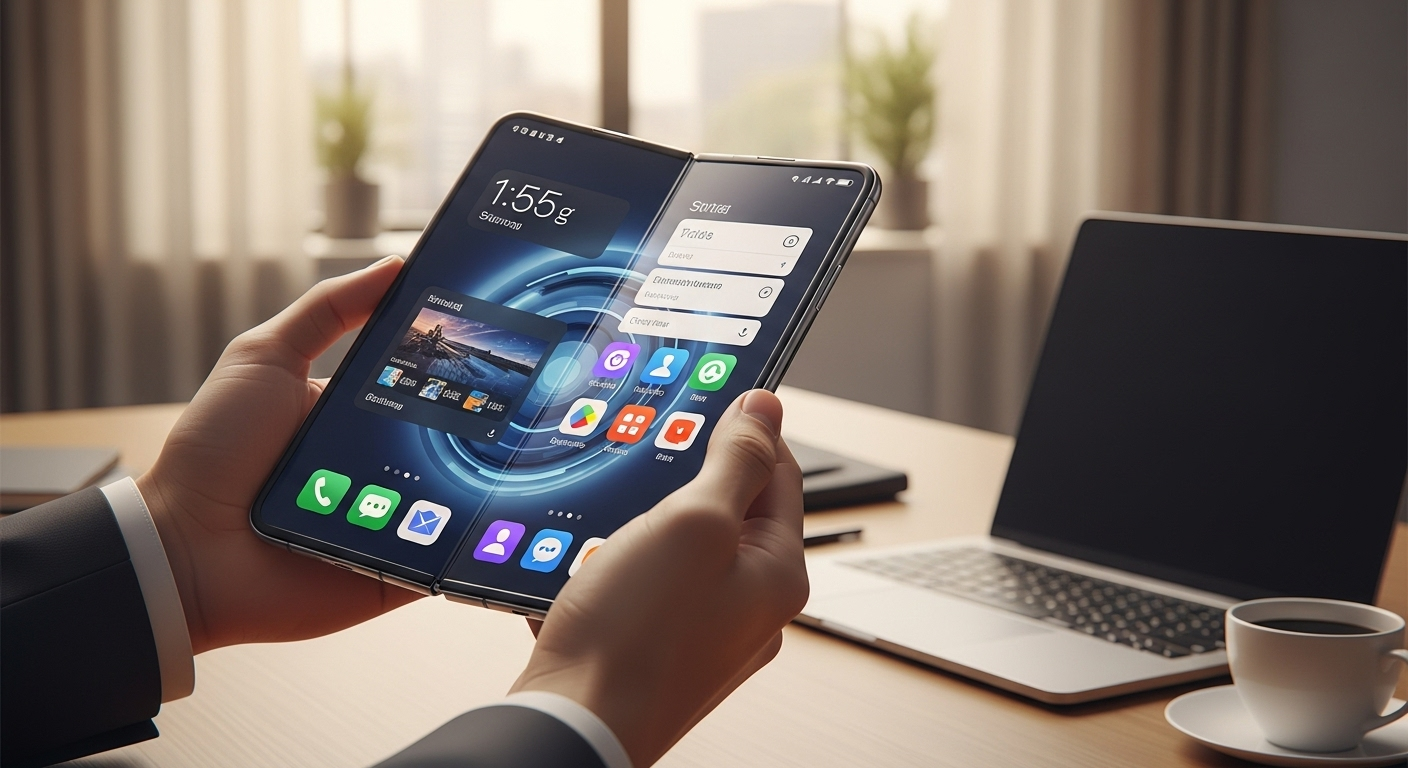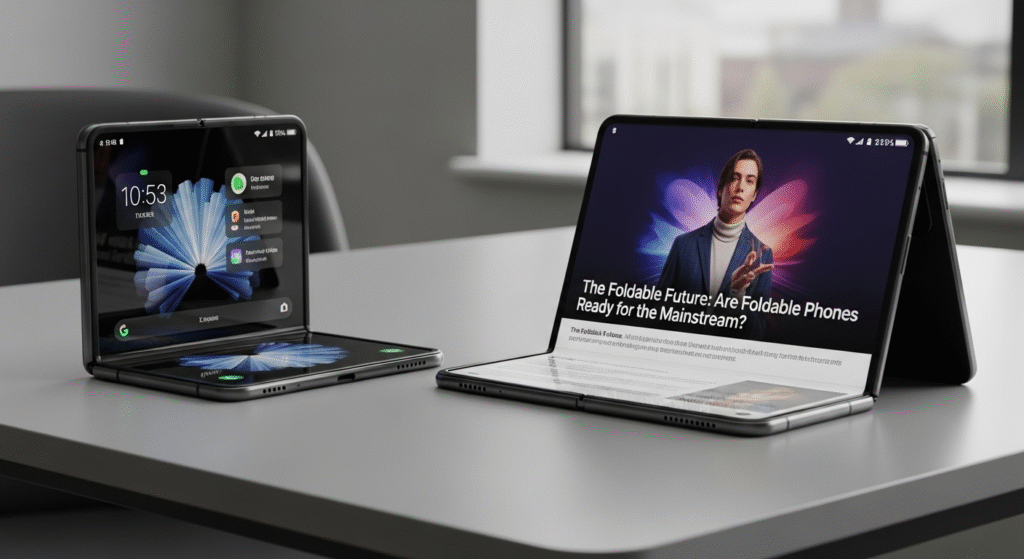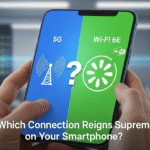Remember flip phones? The satisfying snap as you ended a call? Yeah, well, foldable phones are kinda like that, but, you know, way more advanced. We’re talking flexible screens, multitasking like a boss, and a whole lotta futuristic vibes. But here’s the thing: are they actually ready for everyday life? Or are they still just fancy tech toys for early adopters with deep pockets? That’s the million-dollar question, isn’t it?
I initially scoffed, to be honest. A phone that folds? Seemed gimmicky. But then I saw someone using a foldable on the subway, effortlessly switching from reading an article to watching a video, and… well, I started to get it. The appeal is real. Think about it this way – you get (almost) tablet-sized screen real estate when you want it, and then it shrinks down to something pocketable when you don’t. Pretty neat.
The Allure of the Fold: A New Kind of Mobile Experience

Let’s dive into what makes these foldable phones so darn intriguing. The obvious thing is that big, gorgeous display. Reading ebooks, browsing the web, or even editing documents becomes a much more immersive experience. And then there’s the multitasking. Running two apps side-by-side feels genuinely useful, especially if you’re trying to, say, compare product reviews while online shopping (guilty!).
But it’s not just about size. The form factor itself opens up new possibilities. Some foldables can prop themselves up like a tiny laptop, perfect for video calls or watching movies on the go. Others let you use the folded screen as a viewfinder for taking selfies with the much better rear camera. It’s clever stuff.
Of course, all this innovation comes at a price. And that price is, well, a pretty hefty price tag. These phones are expensive, often twice as much as a flagship smartphone. Are the features worth the cost? That depends on your needs and priorities. I think it’s also important to consider the fragility factor. All that bending and flexing… it just feels like something that could break easily, doesn’t it? I keep coming back to this point, because it’s crucial.
The Challenges of the Foldable Form Factor
Let’s be real. Foldable phones aren’t perfect. That crease in the middle of the screen? It’s noticeable. Some people find it distracting, others barely notice it after a while. But it’s there. And then there’s the software. Android has come a long way in supporting foldable devices, but app optimization is still a bit hit-or-miss. Some apps scale beautifully to the larger screen, others look stretched and awkward. It’s a mixed bag.
Battery life can also be a concern. That big screen sucks up power, and depending on how heavily you use it, you might find yourself reaching for a charger more often than you’d like. And let’s not forget about durability. While manufacturers are constantly improving the hinge mechanisms and screen materials, foldables are still generally more delicate than traditional smartphones. Dropping one on the sidewalk could be a very expensive mistake. Think about it this way, you’re betting on a screen that’s designed to bend thousands of times not to break when it’s not supposed to.
But hey, every new technology has its growing pains, right? Remember the first smartphones? They were clunky, slow, and had terrible battery life. But they evolved. And I suspect foldable phones will too. This technology is not without its imperfections, and the current price points could be prohibitive for most consumers.
Foldable Phones and the Future of Mobile Technology
So, are foldable phones a glimpse into the future of mobile technology? Maybe. I think they definitely represent an exciting evolution. They push the boundaries of what’s possible and offer a truly unique user experience. Whether they become a mainstream phenomenon remains to be seen. I believe that, as technology becomes more advanced, it may take a while before it becomes easily accessible, but will eventually lead to the masses.
The frustrating thing about this topic is that it’s constantly evolving. New models are being released all the time, with improved designs, better software, and (hopefully) more affordable prices. The competition is heating up, which is good news for consumers. Actually, that’s not quite right – the competition is only beginning, which means the models could drastically improve over the course of the next few years.
But, honestly, it’s more than just the hardware. It’s about how we interact with our devices. Foldable phones have the potential to change the way we work, play, and connect with each other. Think about creative professionals using the large screen for editing photos or videos on the go. Or students collaborating on projects with multiple apps open side-by-side. The possibilities are endless. This has a certain draw. I find myself gravitating to foldable tech in my future.
FAQ: Foldable Phones – Your Burning Questions Answered
Are foldable phones durable enough for everyday use?
That’s the big question on everyone’s mind, right? And it’s a fair one. While manufacturers have made huge strides in improving durability, foldable phones are still generally more delicate than traditional smartphones. The screens are made of flexible plastic, which is more prone to scratches and dents than glass. And the hinge mechanism is a potential point of failure. However, with careful use and a good case, you can minimize the risk of damage.
How do I know if a foldable phone is right for me?
Think about how you use your phone. Do you frequently multitask? Do you consume a lot of content like videos or ebooks? Do you value portability? If you answered yes to these questions, a foldable phone might be a good fit. But also consider your budget. Foldable phones are a significant investment, so make sure you’re willing to pay the premium for the features they offer. Consider if you are also looking for a phone that stands out from the crowd.
What is the battery life like on foldable phones?
Because of the larger display, they are typically more demanding. This is why battery life will depend on how heavily you use the device. If you’re constantly using the large screen for gaming or watching videos, you’ll likely need to charge it more often. Some foldable phones have impressive battery capacity to compensate, but it’s something to keep in mind. Look at the specifications closely before you buy.
Are foldable phone screens easily scratched?
Yes, foldable phone screens are generally more prone to scratches than traditional glass screens. They’re made of flexible plastic, which is inherently softer. However, most foldable phones come with a pre-applied screen protector. It’s highly recommended to keep it on, or invest in a good quality aftermarket protector, to minimize the risk of scratches. A little extra care can go a long way.
Ultimately, whether or not foldable phones are ready for the mainstream is a matter of perspective. They’re not perfect, but they’re undeniably exciting. And as the technology continues to evolve, they’re only going to get better. I, for one, am excited to see what the future holds. And remember, the early bird gets the worm!



